NMR Data Acquisition The process of data acquisition results in an ...
NMR Data Acquisition The process of data acquisition results in an ...
NMR Data Acquisition The process of data acquisition results in an ...
Create successful ePaper yourself
Turn your PDF publications into a flip-book with our unique Google optimized e-Paper software.
Dictionary <strong>of</strong> <strong>NMR</strong> Parameters. What follows is a list <strong>of</strong> the most import<strong>an</strong>t <strong>NMR</strong><br />
acqusition parameters, with their names <strong>in</strong> both "Brukerese" <strong>an</strong>d "Vari<strong>an</strong>ese" <strong>an</strong>d a brief<br />
expl<strong>an</strong>ation. Keep <strong>in</strong> m<strong>in</strong>d that ch<strong>an</strong>g<strong>in</strong>g <strong>an</strong> <strong>acquisition</strong> parameter has no effect on the <strong>data</strong> (FID<br />
or spectrum) unless you repeat the <strong>acquisition</strong> with the new parameter sett<strong>in</strong>g.<br />
Spectral Width: SW (Bruker <strong>an</strong>d Vari<strong>an</strong>). <strong>The</strong> spectral width is the width <strong>of</strong> the spectral<br />
w<strong>in</strong>dow <strong>in</strong> Hz, from the left edge <strong>of</strong> the spectrum to the right edge <strong>of</strong> the spectrum. Thus, to<br />
"cover" a proton chemical shift r<strong>an</strong>ge <strong>of</strong> 10 ppm to -1 ppm on a 300 MHz spectrometer, we need<br />
a spectral width <strong>of</strong> 11 ppm, which is 11 X 300 or 3,300 Hz. Any peak which is more th<strong>an</strong> 5.5<br />
ppm (1,650 Hz) from the center <strong>of</strong> the spectral w<strong>in</strong>dow (4.5 ppm) will be <strong>in</strong>correctly determ<strong>in</strong>ed<br />
as fas as frequency is concerned. <strong>The</strong> tricky th<strong>in</strong>g is that the peak is not simply ignored; it<br />
appears <strong>in</strong> your spectrum with <strong>an</strong> erroneous frequency, <strong>an</strong>d usually <strong>an</strong> erroneous phase as well.<br />
<strong>The</strong>se "aliased" peaks c<strong>an</strong> be elim<strong>in</strong>ated simply by <strong>in</strong>creas<strong>in</strong>g the spectral width <strong>an</strong>d try<strong>in</strong>g aga<strong>in</strong>.<br />
Cont<strong>in</strong>u<strong>in</strong>g with this example, a spectral width <strong>of</strong> 3,300 Hz requires that we collect a real,<br />
imag<strong>in</strong>ary pair <strong>of</strong> <strong>data</strong> po<strong>in</strong>ts every 30.3 µs (Vari<strong>an</strong>), or a s<strong>in</strong>gle <strong>data</strong> po<strong>in</strong>t every 15.15 µs<br />
(Bruker). To collect 16,384 <strong>data</strong> po<strong>in</strong>ts (8,192 pairs) will take <strong>an</strong> <strong>acquisition</strong> time <strong>of</strong>:<br />
AT = NP / (2 * SW) = 16,384 / (2 * 3,300) = 2.482 seconds<br />
<strong>Acquisition</strong> Time: AT (Vari<strong>an</strong>) or AQ (Bruker). <strong>The</strong> length <strong>of</strong> time required to collect<br />
the <strong>data</strong> <strong>of</strong> a s<strong>in</strong>gle FID. Be careful not to confuse this with the recycle time, which also <strong>in</strong>clude<br />
the pulse width (PW) <strong>an</strong>d the relaxation delay (D1 or RD), or with the length <strong>of</strong> time for the<br />
entire experiment, is the number <strong>of</strong> repeats times the recycle time. If you ch<strong>an</strong>ge the spectral<br />
width (SW), Bruker will automatically ch<strong>an</strong>ge the <strong>acquisition</strong> time (AQ), but Vari<strong>an</strong> will keep<br />
<strong>acquisition</strong> time (AT) const<strong>an</strong>t <strong>an</strong>d ch<strong>an</strong>ge the number <strong>of</strong> po<strong>in</strong>ts (NP). <strong>The</strong> <strong>acquisition</strong> time<br />
should be long enough to <strong>in</strong>clude the full decay <strong>of</strong> the FID <strong>in</strong>to noise; <strong>an</strong>y longer time will only<br />
decrease the signal-to-noise ratio <strong>of</strong> your spectrum s<strong>in</strong>ce you are collect<strong>in</strong>g only noise.<br />
Number <strong>of</strong> <strong>Data</strong> Po<strong>in</strong>ts: NP (Vari<strong>an</strong>) or TD (Bruker). <strong>The</strong> total number <strong>of</strong> <strong>data</strong> po<strong>in</strong>ts<br />
(real or imag<strong>in</strong>ary) <strong>in</strong> <strong>an</strong> FID. <strong>The</strong>re is no confusion here between Vari<strong>an</strong> <strong>an</strong>d Bruker on the<br />
def<strong>in</strong>ition, but some s<strong>of</strong>tware packages for <strong>NMR</strong> <strong>data</strong> <strong>process</strong><strong>in</strong>g (e.g., Felix), measure the size<br />
<strong>of</strong> the <strong>data</strong> set <strong>in</strong> terms <strong>of</strong> the number <strong>of</strong> pairs (real, imag<strong>in</strong>ary) <strong>of</strong> <strong>data</strong> po<strong>in</strong>ts. Both Bruker <strong>an</strong>d<br />
Vari<strong>an</strong> provide for the possibility <strong>of</strong> enlarg<strong>in</strong>g the <strong>data</strong> set by add<strong>in</strong>g zeros after the actual <strong>data</strong><br />
("zero-fill<strong>in</strong>g") before the Fourier tr<strong>an</strong>sform. This is done to give better def<strong>in</strong>ition <strong>of</strong> peak shapes<br />
by us<strong>in</strong>g more po<strong>in</strong>ts to def<strong>in</strong>e the spectrum. Thus, the total number <strong>of</strong> <strong>data</strong> po<strong>in</strong>ts before the<br />
Fourier tr<strong>an</strong>sform (<strong>in</strong>clud<strong>in</strong>g these zeros) is called SI ("size", Bruker) or FN ("Fourier number",<br />
Vari<strong>an</strong>). If you save your <strong>data</strong> to the disk, the size <strong>of</strong> the file will be directly proportional to the<br />
number <strong>of</strong> po<strong>in</strong>ts.<br />
Offset: TO (Vari<strong>an</strong>) or O1 (Bruker). <strong>The</strong> <strong>of</strong>fset (or tr<strong>an</strong>smitter <strong>of</strong>fset) sets the position<br />
<strong>of</strong> the center <strong>of</strong> the spectral w<strong>in</strong>dow. For example, if the normal spectral w<strong>in</strong>dow for 1 H on a<br />
200 MHz <strong>in</strong>strument extends from 11 ppm to -1 ppm <strong>an</strong>d you w<strong>an</strong>ted to <strong>in</strong>stead cover the region<br />
13 ppm to 1 ppm, you would simply add 400 Hz (2 ppm) to the value <strong>of</strong> TO (or O1 on the<br />
Bruker). <strong>The</strong> <strong>of</strong>fset represents a correction (<strong>in</strong> Hz) added to the generic radio frequency (e.g.,<br />
35



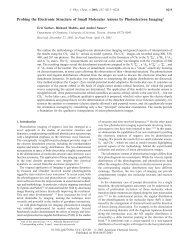

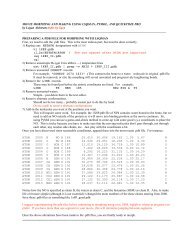


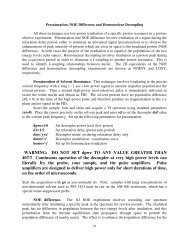


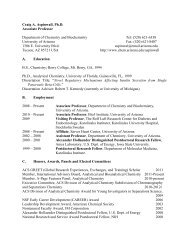
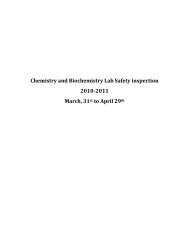
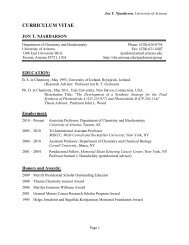
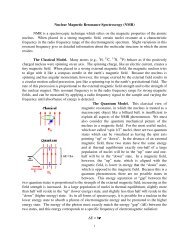
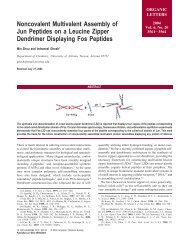
![Program [pdf] - Department of Biochemistry and Molecular ...](https://img.yumpu.com/8309921/1/167x260/program-pdf-department-of-biochemistry-and-molecular-.jpg?quality=85)